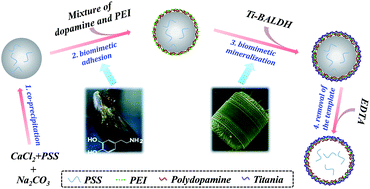Synthesis of organic–inorganic hybrid microcapsules through in situ generation of an inorganic layer on an adhesive layer with mineralization-inducing capability†
Abstract
In this study, a facile and efficient route to prepare organic–inorganic hybrid microcapsules is developed by in situ generation of an inorganic layer on an adhesive layer with mineralization-inducing capability under mild conditions. In detail, the hybrid microcapsules are synthesized through sequential deposition of an organic layer (adhesive layer) and an inorganic layer (mineral layer) on the surface of CaCO3 microparticles, followed by the removal of CaCO3 microparticles via EDTA treatment. During the preparation process, the organic layer is formed through the blending of cationic polyethylenimine (PEI) and polydopamine (PDA) derived from the spontaneous oxidative polymerization of dopamine. The inorganic layer (mineral layer) is formed through the hydrolysis/condensation of a titania precursor induced by the PEI motifs on the surface of the organic layer. The chemical/topological structures of the microcapsules are characterized by several characterization techniques, including Fourier transform infrared spectroscopy, scanning electron microscopy, transmission electron microscopy, and so on. As an example, these (PDA–PEI)/titania hybrid microcapsules are utilized as the carriers for catalase (CAT) encapsulation. In comparison to the free CAT, the encapsulated CAT displays significantly enhanced thermal, pH and storage stability. Further attempts of dye adsorption using this microcapsule and glucose sensing using glucose oxidase/catalase (GOx/CAT)-encapsulated microcapsules are also made for evaluating the potential of this microcapsule in much wider application areas. This route may open a generic, facile and efficient way to prepare permeable hybrid materials for a variety of applications, including catalysis, wastewater treatment, (bio)sensing, etc.


 Please wait while we load your content...
Please wait while we load your content...